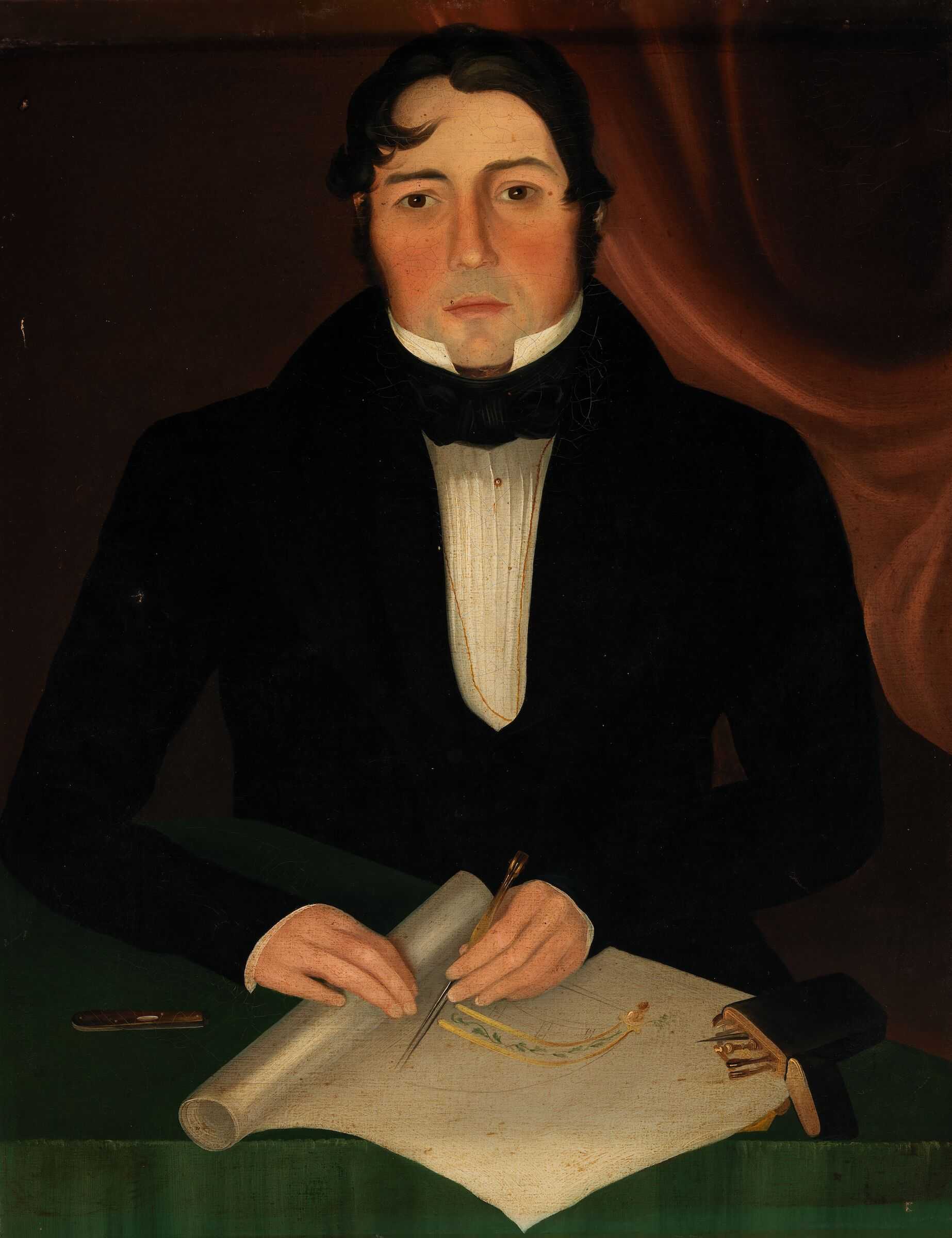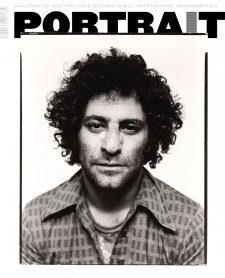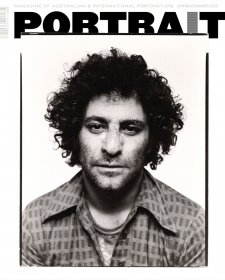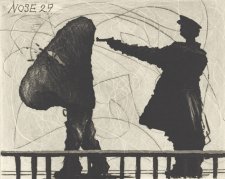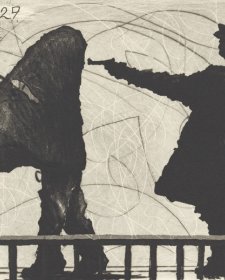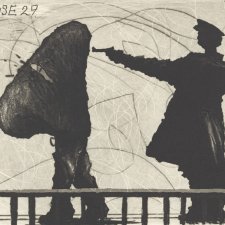Tasmania as an undesirable place: remote in location, wild in aspect, and irretrievably blighted by its reputation as the harshest, most reviled of penal outposts. The material culture of the period, however, provides an alternative view.
Although the colony initially grew slowly, within two or three decades of its establishment in 1803 its role as a prison was in an odd, almost symbiotic coexistence with a settler society that was rude in health, complex in composition and vigorous in its efforts to assert itself as industrious, proud and respectable. Van Diemen’s Land, as it was first known, was attractive to free settlers and ex-convicts alike for its climate, land and opportunities in trade, farming, wool and whaling, by the 1830s making it home to those whose wealth, ill-gotten or not, enabled the establishment and maintenance of polished, elegant lifestyles.
As the Hobart Town Almanack of 1836 explained: ‘There is always a tendency in civilized communities to carry the range of domestic comfort beyond its limits into the realms of luxury, and however much one would have thought, that even in the former, we should be abridged in the first periods of a new colony, I assure my reader that, on the contrary, he will find in Hobart town every license given to finery and extravagance’. Paintings were among the ‘domestic comforts’ sought and by the 1840s, both Hobart and Launceston were supporting a number of practitioners answering the demand for art as proof of status, wealth and social mobility.
As a number of art historians have observed, this didn’t necessarily bode well for the overall quality of the artworks produced in Australia in this period, with would-be patrons having to make do with a limited number of professional artists who varied greatly in fundamentals like skill and training. True, at the high end of the available spectrum were artists like John Glover (1767–1849), already a prosperous and eminent landscape painter with a solid Royal Academy exhibition history when he emigrated to Van Diemen’s Land in 1831; while those wanting a charming, expertly executed portrait would most likely seek out the services of Thomas Bock (1790–1855), a painter and printmaker who’d arrived in Hobart a convict, but who later established himself as portrait painter to ‘our most esteemed and venerated colonists’. But not every artist plying his trade in Hobart in, say, the 1830s, was as accomplished as Glover and Bock and the less elevated sector of the spectrum was occupied by artists working in the journeyman mode and those who might produce works in various mediums and styles in order to make a living in a market that was avidly materialistic in spite of its size and isolation. The result is a visual record of the period and its people that ranges from consummate to clumsy, this unevenness lending what has been termed an idiosyncratic quality to colonial Australian art. By this backhanded assessment, a number of artists have been relegated to the category of curiosity, their work on occasion deemed quaint, worthy primarily for what it evinces about artistic activity in the colony at the time and for its use as a record of places, things and people. As art historian Joan Kerr explained in 1988, Australian art of the colonial period was on a par with that being produced in provincial Britain at the same time, functioning mainly as the ‘handmaid of science, commerce, gentility and so on’ and distinguished by ‘the primacy of some non-aesthetic purpose’.
This characteristic resides in the work of William Buelow Gould (1803–1853) who arrived in Hobart in December 1827 under sentence of transportation for seven years, his crime being the theft of an overcoat. Like Bock and several others whose colonial careers came about through transgression, Gould – whether out of desperation, resignation or want of any other option – attempted to fashion something from his ignominious situation, utilising sympathy to advantage when he could and later trying, at least, to earn an honest living as a painter. Unlike Bock, however, Gould never quite overcame the deficiencies of integrity and prudence that had occasioned his troubles in the first place. More feckless git than hardened reprobate, Gould’s misfortunes were largely dictated by a taste for gambling and a hopelessly unrestrained predilection for booze, the terms ‘intoxication’ and ‘drunk’ featuring regularly in the record of his conduct as a convict and reports of his subsequent behaviour, just as the names of certain drinking establishments appear at pertinent points in his earlier history. Yet despite this trait and numerous consequent run-ins with the law, between 1830 and his death in Hobart in 1853, Gould managed to produce a body of work that encompassed each of the genres typically practised in the provinces – landscape, botanical and natural history illustration and portraits, in watercolour and oils. As an added bonus, from the late 1830s, Gould called regularly on the experience he is said to have gained as a porcelain painter to produce still lifes, hunting scenes, and conversation pieces, making him the only artist in Australia in this period known to have specialised in such imagery. Descriptions of Gould’s paintings have commonly employed the use of terms like naïve, unconvincing, simple and primitive, their variable quality underlining his truncated training and tradesman-like background. Yet his work is somehow richer for its flaws and subject matter, these elements coalescing instead to supply a useful and vivid witness to the society he occupied and the conditions in which he and his similarly inexpert contemporaries operated.
Born William Holland in Liverpool in 1803, Gould occupies that class of artist who, in another of Australian colonial art’s pleasing idiosyncrasies, would have remained unknown were it not for his falling foul of the law. The little that is known of Gould’s life prior to transportation was for a long time gleaned from the mentions made of him in the diary kept by Robert Martin, the First Officer on the Asia, the ship aboard which Gould and 199 other convicts made the four-month trip to Hobart in 1827. The diary shows Martin to have been a moody, sensitive type, someone who tried easing the tedium of the journey with reading, mathematics, writing and whist, subject occasionally to what he termed his ‘blue devils’ and capable of feeling sympathy, even for a blackguard like Gould. ‘This poor wretch’, Martin wrote, ‘is another example of the baneful effects produced by gambling’. Subsequently expanded by the research of curators and historians, Martin’s summary – presumably from the word of Gould himself – outlines Gould’s decidedly wretched situation as originating in his being so ‘fond of play’ that he became ‘a regular member of a set of sharpers’ in Liverpool, his vices later leading him to London. As Martin’s account suggests, it was during the next couple of years that Gould gained his training in art, allegedly working for a time with Rudolph Ackermann, a carriage designer and publisher who managed a highly successful business that traded in illustrated books and printed ‘views’, among them engraved scenes of the Australian colonies. Gould also claimed to have had some tuition in painting around this time from William Mulready, an Irish-born Royal Academician whose speciality in genre paintings and emulation of the work of Dutch masters has been read by some as significant given the subject matter of much of Gould’s later output. In late 1823, Gould is said to have left London to evade the negative implications of an association with a man named John Thurtell, one of his drinking and gambling companions, who was convicted of murder and hanged for this crime in January 1824. Gould went briefly back to Liverpool and then to Staffordshire, where he is believed to have found work as a porcelain painter at Spode’s pottery, then at the peak of its operation as a manufacturer of fine, decorated china for both middling and high-end consumers. By mid-1826, his name changed and his short-lived marriage abandoned, Gould was in Northampton, picking up his first conviction there in August and serving three months in gaol for having purloined paint, brushes and ‘other articles’. Literally within weeks of completing this sentence Gould was again before a judge on charges of thieving, the court concluding second time round that banishment to Van Diemen’s Land was befitting him. Gould was duly sent to the prison hulks at Portsmouth to wait out the months between his sentencing, in January 1827, and the Asia’s departure in early August the same year.
Gould’s stated ‘profession’ garnered the attention of Martin and other officers and within a few weeks of leaving England he was taking likenesses, either out of boredom on the part of his sitters or their genuine interest in his welfare. Martin described Gould’s first shipboard portrait as a ‘caricature’, but the second was a ‘tolerable good one’ and enough to induce Martin to sit for one himself.
‘Gould the convict painter began a likeness of me, or something intended to be one’, he wrote. Having completed a few portraits, presumably in pencil and watercolour, Gould went on to oils, producing a passable painting of Captain Boscawen that prompted Martin to gift the convict his small assortment of paints and have another go at posing for him. Interestingly, Martin’s assessment of Gould’s shipboard output – awkwardness and imperfection punctuated with dexterity and finesse – provides something of a gauge as to how his career in the colony would pan out: ‘Sitting for my likeness through the day to Gould who makes a good sketch and gradually spoils all likeness in finishing’, Martin writes one day, concluding the next that the portrait ‘I fear is a failure but I do not like to tell him so’, and on another occasion noting ‘he seems to excel in flower painting’.
Likewise, the work Gould produced once he got here was motley in quality, just as his personal experience wavered in keeping with his weaknesses. Though designated ‘a portrait painter’ on his convict record and considered useful for his knowledge of the pottery trade, Gould’s worth dwindled quickly in the face of his additional misdemeanours, the first – ‘Being in a Public house called the Jolly Sailor in a state of intoxication after 9.00 o’clock on a Saturday night’ – recorded the month following his arrival and punished with two weeks on a chain gang.
In June 1829, having been found guilty of attempting to pass a fake banknote, Gould was sentenced to three years at Sarah Island, the secondary punishment station in Macquarie Harbour on the west coast. Among those left for dead when some of the convicts on the ship transporting him and thirty other prisoners to Macquarie Harbour mutinied, Gould attempted to score himself some points, if not a pardon, by volunteering with four others to walk around 60 miles to Hobart to raise the alarm. Instead, Gould was rewarded for not taking this chance to escape by assignment to the Colonial Surgeon, James Scott, who, like many colonial officials, was partial to a spot of botany.
It was through this twisted stroke of luck that Gould returned to painting, producing at Scott’s request much of what the Hobart Town Chronicle later described as ‘one of the most splendid collections of inimitable drawings, not only of the plants but most of the birds of this island’. Given his repeated resorts to grog and regular instances when he was ‘absent from his Master’s service without leave‘ – with resultant floggings, stints on the tread-wheel and other penalties – it must only have been because of Gould’s proficiency that Scott put up with him. Hardly the work of a ham-fisted amateur, the fine and detailed botanical drawings Gould made while in Scott’s service demonstrate his skill with watercolour, lending a degree of credibility to one 1833 reference to him being ‘formerly one of Ackermann’s best draftsmen’. Sentenced to Macquarie Harbour for the second time in 1832 and assigned to the settlement’s medical officer, William de Little, Gould produced botanical drawings, topographic views and a few portraits, as well as his exquisite ‘Sketchbook of fishes’, a collection of thirty-six watercolours of marine creatures so accurately and daintily delineated as to leave little doubt as to Gould’s capabilities when there was no choice for him but to stay off the turps and work.
Accordingly, Gould faltered personally and professionally following the expiration of his sentence in 1835. After a period in Launceston, where he produced stage backdrops and was engaged as a painter of armorial decorations by a local coachbuilder, Gould returned to Hobart. In December 1836, he married ex-convict Amy Reynolds, James Scott’s erstwhile housemaid, a wife – and, later, five children – necessitating that he earn a living from his painting. In another, more discerning market, Gould would have found his paintings deemed inferior and workmanlike, but in colonial Hobart, his lack of consistency, character and credentials wasn’t necessarily a downside. Gould’s artisan- style beginnings in the game provided sufficient mastery for him to be useful in a society that was unspoilt for choice but unashamedly commercial, making the skills he had exactly the sort that could be put to use in his half-baked efforts at redemption. He was prolific and adaptable, as shown by the Hobart Repository of Arts advising in 1837 that it had ‘always on sale ... a collection of Drawings of flowers, fruit, native plants, shrubs, birds, fishes, &c. by that celebrated and eccentric genius, Gould’. Gould was also advantaged by his speciality in the sort of works that best answered the requirements of rough-around-the edges clients, the people enriched and ennobled by such lowbrow means as emporiums, hostelries, whale oil, tanneries and trades. Still lifes, for instance, were in demand as ornamental elements for genteel and aspiring homes, while socalled sporting and hunting pictures, showing arrangements of guns and dead game, typically served the same purpose in hotels, games rooms and gentleman’s lodgings. Decorative, flat, and betraying his porcelain-painting experience, certain examples, fittingly, are somehow more like pub signs than fine art: The Cat and Catch, The Hare and Pheasant, The Fruit and Flowers and so on. The story goes that Gould was usually so skint that he paid his creditors, namely publicans, with paintings, perhaps partly explaining why such a healthy proportion of these otherwise formulaic compositions are distinguished by the clear signature, ‘WB Gould, Painter’.
Much fewer in number but just as illustrative of Gould’s aptitude for capturing the alternately refined and boorish nature of his place and times are his portraits. Those that are still extant demonstrate Gould’s wit and suitability for caricature, such as in his watercolours of a pipe-toking landlord and his lady, but his less-assured handling of oil paint and the formal or stately portrait style, recalling Robert Martin’s point that Gould ‘made a good sketch’ but then ‘spoiled all likeness in finishing’. The ambition, however, of Gould’s 1838 self-portrait and his few commissioned depictions – such as those of John and Sarah Marney, a Port Arthur prison warder and his wife; John Mezger, a businessman whose numerous lucrative ventures included a Hobart ‘wine and spirit house’, the Bird in Hand; and John Eason, a shipwright responsible for the construction of several whaling and trading vessels throughout the 1840s – reveals a sense of hope in his own prospects along with the makedo attitude of colonial consumers and the aspirations and pride of humble men-made-good. Mezger’s dishevelled and ruddy person is trussed up in fine clothing; Eason, equally well-attired, is depicted in possession of gold geometrical instruments as well as a watch-chain and pin; while both sitters, with their oddly-proportioned arms and imperfectly executed hands, are backgrounded with drapery, a standard feature of elegant and idealised portraits of the period.
As one expert has already observed, Gould’s portraits were ‘inevitably stiff, poorly drawn, and badly coloured’, flaws that, as with particular examples of his still life paintings and landscapes, are indicative of patchy training and a practise marred by penury, booze, infirmity and continued indiscretion. The same reasons, however, are those that render Gould’s work ‘compelling [and] forceful’, as if the combination of his dodgy and pitiable personal circumstances with the ill-formed sensibilities of the people he worked for has gilded his output with a worth that far exceeds a bare and clinical emphasis on ability. In serving a ‘nonaesthetic purpose’, Gould created works that are oddly more valuable for being rudimentary and documentary, their limitations – whether of skill, subject or both – providing a telling record of colonial society as well as an allusion to Gould’s own mixed and ultimately sad experiences. In a related vein, Gould’s fine and precisely-executed drawings of Macquarie Harbour fish, argued by some authorities on his work to be his most effective portraits, are still consulted by scientists and have been accorded the equivalent of World Heritage status for their value as proof that artistry could flourish in the most uncouth and brutish of circumstances. So too, his later paintings demonstrate that it was possible for Gould to function as an artist irrespective of the hopeless and hostile conditions of convictism, alcoholism, exile and indigence. His works are arguably as valuable for being made with science, decoration, vanity and other ‘non-aesthetic’ motivations in mind, their variability instead making them testament to the complex and contradictory character of the community he occupied. William Buelow Gould mightn’t necessarily stand up to the rigours of an analysis that prioritises aesthetics and technical proficiency, but he will continually come up trumps in one which recognises eloquence in simplicity, clarity in clumsiness, and richness in the roguish and commonplace.
